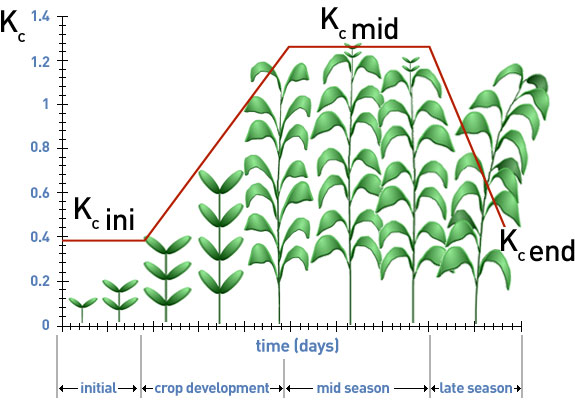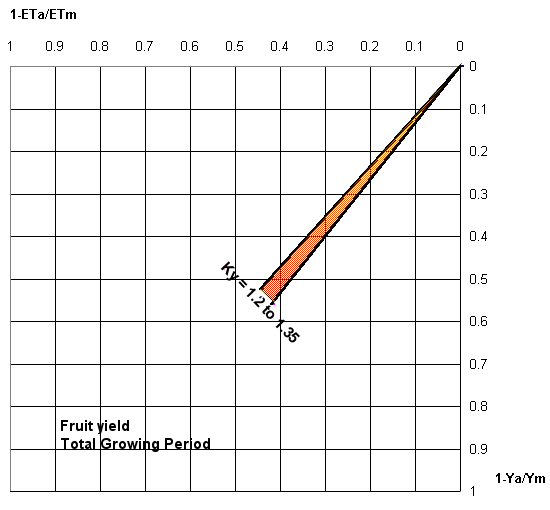Banana
This section presents information on water relations and water management of banana and provides links to other sources of information.
Crop Description and Climate
Crop Description and Climate
Banana (Musa spp.) is one of the most important tropical fruits. Ripe banana fruits are sugary and eaten raw; unripe fruits, called plantains, are cooked and provide a starchy food with nutritional value similar to potato. Total world production of banana is about 68.6 million tons of fresh fruit (FAOSTAT, 2001).
The cultivated banana is believed to have originated in the lowland, humid tropics in Southeast Asia and is mostly grown between 30°N and S of the equator. A mean temperature of about 27°C is optimal for growth. Minimum temperature for adequate growth is about 16°C, below which growth is checked and shooting delayed. Temperatures below 8°C for long periods cause serious damage. Maximum temperature for adequate growth is about 38°C, depending on humidity and the radiation intensity. Bananas are day-neutral in their response to daylength.
A humidity of at least 60 percent or more is preferable. Strong winds, greater than 4 m/sec, area major cause of crop loss due to the pseudostems being blown down. Under high wind conditions windbreaks are desirable.
Bananas can be grown on a wide range of soils provided they are fertile and well-drained. Stagnant water will cause diseases such as the Panama disease. The best soils are deep, well-drained loams with a high water holding capacity and humus content. Optimum pH is between 5 and 7. The demands for nitrogen and especially potash are high. Since the early stages of growth are critical for later development, nutrients must be ample at the time of planting and at the start of a ratoon crop. Short intervals between fertilizer applications, especially nitrogen, are recommended. Fertilizer requirements are 200 to 400 kg/ha N, 45 to 60 kg/ha P and 240 to 480 kg/ha K per year.
Banana is very sensitive to salinity and soils with an ECe of less than 1 mmho/ cm are required for good growth.
Banana, 2 to 9m tall, bears leaves on a pseudostem consisting of leaf stalks. The flowering stalk emerges (shooting) from the pseudostem and produces a hanging bunch of flowers. Fruits are formed on 'hands' with about 12 fingers; each bunch contains up to 150 fingers. After harvest the pseudostem is cut. The underground stem (corm or rhizome) bears several buds which, after sprouting, form new pseudostems, or so-called suckers. They are removed except for one or two which provide the ratoon crop.
Banana is normally multiplied vegetatively. Several types of suckers can be used. The development of the plant can be divided into three periods: vegetative, flowering and yield formation. The time from planting to shooting (vegetative) is about 7 to 9 months, but with lower temperatures at higher altitudes or in the subtropics, up to 18 months. The time from shooting to harvest (flowering and yield formation) is about 90 days. In tropical lowlands the time to harvest of the next ratoon crop is about 6 months. The number of ratoons varies. The average life of a commercial plantation can be from 3 to 20 years; with mechanical cultivation the economic life is often 4 to 6 years. Some varieties are replanted after each harvest.
Planting distances vary according to variety, climate, soil and management and are between 2 x 2 m and 5 x 5 m, corresponding to a density of 400 to 2500 plants/ha. On steep slopes contour planting is practised. The crop is sometimes interplanted or is used as a nurse crop for crops such as cocoa.
Following figure presents the development of banana (Champion, 1963)


Stages of Development | Plant date | Region | |||||
|---|---|---|---|---|---|---|---|
Crop characteristic | Initial | Crop | Mid- season | Late | Total | ||
Banana 1st year | |||||||
Stage length, days | 120 | 90 | 120 | 60 | 390 | March | Mediterranean |
Depletion Coefficient, p | 0.35 | >> | 0.35 | 0.35 | - |
| |
Root Depth, m | 0.80 | >> | >> | 0.80 | - |
| |
Crop Coefficient, Kc | 0.5 | >> | 1.1 | 1.0 | - |
| |
Yield Response Factor, Ky | 1.2-1.35 | - |
| ||||
Banana 2nd year | |||||||
Stage length, days | 120 | 06 | 180 | 5 | 365 | February | Mediterranean |
Depletion Coefficient, p | 0.35 | >> | 0.35 | 0.35 |
| ||
Root Depth, m | 0.80 | >> | >> | 0.8 | - |
| |
Crop Coefficient, Kc | 1.0 | >> | 1.2 | 1.1 | - |
| |
Yield Response Factor, Ky | 1.2-1.35 |
| |||||
Being a long duration crop, the total water requirements of banana are high. Water requirements-per year vary between 1200 mm in the humid tropics to 2200 in the dry tropics. For rainfed production, average rainfall of 2000 to 2500 mm per year, well-distributed, is desirable, but banana often grows under less rainfall.
In relation to reference evapotranspiration (ETo) the maximum water requirements (ETm) can be determined with the crop coefficient (kc), or ETm = kc. ETo.
Following table presents monthly kc values of Banana for subtropical climate
Subtropical climate | kc | |||||||||||
|---|---|---|---|---|---|---|---|---|---|---|---|---|
J | F | M | A | M | J | J | A | S | O | N | D | |
First-year crop, March planting: | ||||||||||||
Humid, light to mod. wind | - | - | .65 | .6 | .55 | .6 | .7 | .85 | .95 | 1.0 | 1.0 | 1.0 |
Second with ratoon starting in February: | ||||||||||||
Humid, light to mod. wind | 1.0 | .8 | .75 | .7 | .7 | .75 | .9 | 1.05 | 1.05 | 1.05 | 1.0 | 1.0 |
Following table presents monthly kc values of Banana for tropical climate
Tropical climate | 1 | 2 | 3 | 4 | 5 | 6 | 7 | 8 | 9 | 10 | 11 | 12 | 13 | 14 | 15 |
|---|---|---|---|---|---|---|---|---|---|---|---|---|---|---|---|
.4 | .4 | .45 | .5 | .6 | .7 | .85 | 1.0 | 1.1 | 1.1 | .9 | .8 | .8 | .95 | 1.05 | |
| suckering | shooting | harvesting | ||||||||||||
Water Supply And Crop Yield
Water Supply And Crop Yield
The relationships between relative yield decrease (1 - Ya/Ym) and relative evapotranspiration deficit for the total growing period are shown in the figure below.

Banana requires an ample and frequent supply of water; water deficits adversely affect crop growth and yields. The establishment period and the early phase of the vegetative period (0-1) determine the potential for growth and fruiting and an adequate water and sufficient nutrient supply is essential during this period. Water deficits in the vegetative period (1) affect the rate of leaf development, which in turn can influence the number of flowers in addition to the number of hands and bunch production
The flowering period (2) starts at flower differentiation, although vegetative development can still continue. Water deficits in this period limit leaf growth and number of fruits.
Water deficits in the yield formation period (3) affect both the fruit size and quality (poorly filled fingers). A reduced leaf area will reduce the rate of fruit filling; this leads, at harvest time, to bunches being older than they appear to be and consequently the fruits are liable to premature ripening during storage
The ratio between relative yield decrease and relative evapotranspiration deficit (ky) is 1.2 to 1.35, with little difference between different growth periods.
Regular water supply under irrigation over the total growing season as compared to rainfed production with seasonal differences in water supply produces taller plants, with greater leaf area, and results in earlier shooting and higher yields. Interval between irrigation has a pronounced effect on yields, with higher yields being achieved when intervals are kept short. Under conditions of limited water supply, total production will be higher when full crop water requirements are met over a limited area than when crop water requirements are partially met over an extended area.
Water Uptake
Water Uptake
The banana plant has a sparse, shallow root system. Most feeding roots are spread laterally near the surface. Rooting depth will generally not exceed 0.75 m. In general 100 percent of the water is obtained from the first 0. 5 to 0.8 m soil depth (D = 0. 5-0.8 m) with 60 percent from the first 0.3 m. With maximum evapotranspiration (ETm) of 5 to 6 mm/day, a 35 percent depletion of the total available soil water should not be exceeded (p = 0.35).
Irrigation Scheduling
Irrigation Scheduling
Since a depletion of total available soil water in excess of about 35 percent during the total growing period is harmful to growth and fruit production, frequent irrigation is important. The irrigation interval will depend on ETm and the soil water holding capacity in the rooting depth and may vary from 3 days under high evaporative conditions and light soils up to 15 days under low evaporative conditions and high water retaining soils. When rainfall and irrigation water is limited, it is advantageous to reduce the depth of each water application rather than to extend the irrigation interval.
Irrigation Methods
Irrigation Methods
Overhead sprinkler systems with small application at frequent intervals are commonly used in commercial banana plantations. Surface irrigation methods include the basin, furrow or trench irrigation systems. The trench system also serves as a drain during the rainy periods. Also drip irrigation is used; with drip irrigation under conditions of high evaporation, low rainfall and particularly when irrigation water contains even a small amount of salt, accumulation of salts at the boundary of wet and dry soil area will occur. Under such conditions leaching will often be needed since banana plants are highly salt-sensitive and damage to the crop can otherwise easily occur.
Yield
Yield
Yields can vary enormously, Under poor management yields are usually highest for the planted (first) crop and decline for the ratoon crops. Under intensive management with correct desuckering and control of pests and. diseases, yields from the first ratoons are usually higher than for the plant crop. Good commercial yields of banana are in the range of 40 to 60 ton/ha. The water utilization efficiency for harvested yield (Ey) of fruits, containing about 70 percent moisture, is 2.5 to 4 kg/m3 for the plant crop and 3.5 to 6 kg/m3 for ratoon crops.
